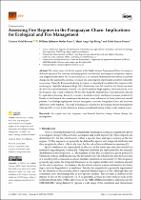Assessing Fire Regimes in the Paraguayan Chaco: Implications for Ecological and Fire Management
Fecha de publicación
29-09-2024Objetivos de desarrollo sostenible
ODS 15 - Vida de ecosistemas terrestres
Tipo
Artículo
Metadatos
Mostrar el registro completo del ítemResumen
This study analyzed the fire regime in the highly diverse Paraguayan Chaco, focusing on different aspects of fire patterns, including spatial (area burned) and temporal (frequency) aspects and magnitude (severity). We focused on fire as it is a natural phenomenon that drives ecosystem change and has significant economic, ecological and social impacts of particular concern in vulnerable ecosystems. Using the K-means clustering technique, we identified four distinct fire regimes in the study region: High (H), Moderately High (MH), Moderately Low (ML) and Low (L). On the one hand, the Dry Chaco predominantly featured Low and Moderately High regimes, characterized by a low fire frequency due to arid conditions. On the other hand, the Humid Chaco was particularly affected by agricultural burning, driven by extensive livestock activity and higher biomass productivity. Finally, in the Pantanal, the variations in fire intensity were influenced by flood pulses and rainfall patterns. Our findings highlight the distinct fire regimes across the Paraguayan Chaco and detail the differences in the regimes. The study’s findings are valuable for developing efficient management strategies that account for fire behaviour during agricultural burning in this poorly studied region.
Palabras clave
Representación
Sede Central
Es parte de
Fire
Status
openAccess
URI enlace
https://doi.org/10.3390/fire7100347


